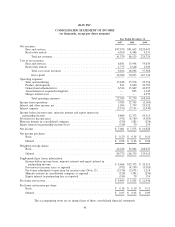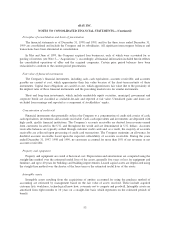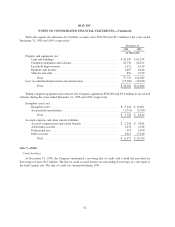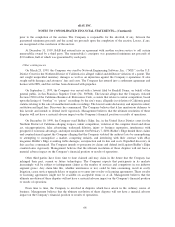eBay 1999 Annual Report Download - page 61
Download and view the complete annual report
Please find page 61 of the 1999 eBay annual report below. You can navigate through the pages in the report by either clicking on the pages listed below, or by using the keyword search tool below to find specific information within the annual report.of events that have been recognized in the Company’s financial statements or tax returns. The measurement of
current and deferred tax liabilities and assets are based on provisions of the enacted tax law; the effects of future
changes in tax laws or rates are not anticipated. The measurement of deferred tax assets is reduced, if necessary,
by the amount of any tax benefits that, based on available evidence, are not expected to be realized.
Comprehensive income
Effective January 1, 1998 the Company adopted the provisions of SFAS No. 130, ‘‘Reporting
Comprehensive Income.’’ SFAS No. 130 establishes standards for reporting comprehensive income and its
components in financial statements. Comprehensive income, as defined, includes all changes in equity (net assets)
during a period from non-owner sources. At December 31, 1997 and 1998, the Company did not have
transactions that were required to be reported in comprehensive income.
Recent accounting pronouncements
In June 1998, the Financial Accounting Standards Board (‘‘FASB’’) issued SFAS No. 133, ‘‘Accounting for
Derivatives and Hedging Activities.’’ SFAS No. 133 establishes accounting and reporting standards for derivative
instruments, including certain derivative instruments embedded in other contracts, and for hedging activities. In
July 1999, the FASB issued SFAS No. 137, ‘‘Accounting for Derivative Instruments and Hedging Activities—
Deferral of the Effective Date of FASB Statement No. 133,’’ which deferred the effective date until the first fiscal
quarter ending on or after June 30, 2000. The Company will adopt SFAS No. 133 in its quarter ending June 30,
2000. The Company has not engaged in significant hedging activities or invested in derivative instruments.
In December 1999, the Securities and Exchange Commission issued Staff Accounting Bulletin (‘‘SAB’’)
No. 101, ‘‘Revenue Recognition in Financial Statements.’’ SAB No. 101 provides guidance for revenue
recognition under certain circumstances. The Company believes the effect of SAB 101 on historical placement
fee revenue is insignificant but has adopted the provision for placement fee revenue in the first quarter of 2000.
As such, placement fee revenue will be recognized ratably over the estimated period of the transaction.
In November 1999, the EITF commenced discussions on EITF No. 99-17, ‘‘Accounting for Advertising
Barter Transactions.’’ The EITF provides guidance on the recognition of Internet barter advertising revenues and
expenses under various circumstances. The EITF reached a conclusion that revenues and expenses from
advertising barter transactions should be recognized at the fair value of the advertising surrendered or received
only when an entity has a historical practice of receiving or paying cash for similar advertising transactions. The
Company does not expect that the adoption of EITF No. 99-17 will have a material impact on its consolidated
financial statements.
Note 2—Net Income per Share:
The Company computes net income per share in accordance with SFAS No. 128, ‘‘Earnings per Share.’’
Under the provisions of SFAS No. 128, basic net income per share is computed by dividing the net income
available to common stockholders for the period by the weighted average number of common shares outstanding
during the period. Diluted net income per share is computed by dividing the net income for the period by the
weighted average number of common and common equivalent shares outstanding during the period. Common
equivalent shares, composed of unvested, restricted Common Stock and incremental common shares issuable
upon the exercise of stock options and warrants and upon conversion of Series A and Series B Convertible
Preferred Stock, are included in diluted net income per share to the extent such shares are dilutive.
eBAY INC.
NOTES TO CONSOLIDATED FINANCIAL STATEMENTS—(Continued)
56
























